Effect of Stand Age on Fine Root Biomass, Production and Morphology in Chinese Fir Plantations in Subtropical China
Abstract
1. Introduction
2. Materials and Methods
2.1. Study Site and Experimental Design
2.2. Fine Root Sampling
2.3. Statistical Analyses
3. Results
3.1. Root Biomass and Necromass
3.2. Fine Root Production and Turnover
3.3. Fine Root Morphology
4. Discussion
4.1. Fine Root Biomass and Necromass
4.2. Fine Root Production and Turnover
4.3. Fine Root Morphology
5. Conclusions
Author Contributions
Funding
Acknowledgments
Conflicts of Interest
References
- Lukac, M. Fine Root Turnover. Meas. Roots 2012, 363–373. [Google Scholar] [CrossRef]
- Borja, D.W. Steffenrem and Majdi. Effect of stand age on fine root biomass, distribution and morphology in a Norway spruce chronosequence in southeast Norway. Tree Physiol. 2008, 28, 773–784. [Google Scholar] [CrossRef] [PubMed]
- Inagaki, M.; Inagaki, Y.; Kamo, K.; Titin, J. Fine-root production in response to nutrient application at three forest plantations in Sabah, Malaysia: Higher nitrogen and phosphorus demand by Acacia mangium. J. For. Res. 2009, 14, 178–182. [Google Scholar] [CrossRef]
- Jia, Q.; Liu, Q.; Li, J. Individual-based fine root biomass and its functional relationship with leaf for Pinus tabuliformis in northern China. Eur. J. For. Res. 2015, 134, 705–714. [Google Scholar] [CrossRef]
- Finer, S.E.; Finer, S.E. The History of Government from the Earliest Times: Ancient Monarchies and Empires; Oxford University Press: Oxford, UK, 1997; Volume 1. [Google Scholar]
- Yuan, Z.Y.; Chen, H. Fine root biomass, production, turnover rates, and nutrient contents in boreal forest ecosystems in relation to species, climate, fertility, and stand age: Literature review and meta-analyses. Crit. Rev. Plant Sci. 2010, 29, 204–221. [Google Scholar] [CrossRef]
- Vogt, K.A.; Grier, C.C.; Vogt, D.J. Production, turnover, and nutrient dynamics of above- and belowground detritus of world forests. Adv. Ecol. Res. 1986, 15, 303–377. [Google Scholar]
- Fukuzawa, K.; Dannoura, M.; Kanemitsu, S.; Kosugi, Y. Seasonal patterns of root production of Japanese oak seedlings and dwarf bamboo grown in rhizoboxes. Plant Biosyst. 2010, 144, 434–439. [Google Scholar] [CrossRef]
- Gill, R.A.; Jackson, R.B. Global patterns of root turnover for terrestrial ecosystems. New Phytol. 2010, 147, 13–31. [Google Scholar] [CrossRef]
- Paudel, T.; Gao, Y.; Lan, Y.; Macmohan, G.; Kempa, K.; Naughton, M.; Ren, Z. Influence of environmental variability on root dynamics in northern forests. Crit. Rev. Plant Sci. 2009, 28, 179–197. [Google Scholar]
- Kizha, A.R.; Han, H.S. Predicting aboveground biomass in second growth coast redwood: Comparing localized with generic allometric models. Forests 2016, 7, 96. [Google Scholar] [CrossRef]
- Helmisaari, H.S.; Derome, J.; Nöjd, P.; Kukkola, M. Fine root biomass in relation to site and stand characteristics in Norway spruce and Scots pine stands. Tree Physiol. 2007, 27, 1493–1504. [Google Scholar] [CrossRef] [PubMed]
- Farfał, D. Root vitality in the upper soil of pine stands ten years after thinning. For. Res. Pap. 2010, 71, 225–230. [Google Scholar] [CrossRef]
- Jagodzin´ski, A.M.; Kałucka, I. Fine root biomass and morphology in an age-sequence of post-agricultural Pinus sylvestris L. stands. Dendrobiology. 2011, 66, 71–84. [Google Scholar]
- Hodge, A. The plastic plant: Root responses to heterogeneous supplies of nutrients. New Phytol. 2004, 162, 9–24. [Google Scholar] [CrossRef]
- Terzaghi, M.; Montagnoli, A.; Iorio, A.D.; Scippa, G.S.; Chiatante, D. Fine-root carbon and nitrogen concentration of European beech (Fagus sylvatica L.) in Italy Prealps: Possible implications of coppice conversion to high forest. Front. Plant Sci. 2013, 4, 192. [Google Scholar] [CrossRef] [PubMed]
- Persson, H.; Ahlström, K.; Persson, H.; Ahlström, K. Fine-root response to nitrogen supply in nitrogen manipulated Norway spruce catchment areas. For. Ecol. Manag. 2002, 168, 29–41. [Google Scholar] [CrossRef]
- Eissenstat, D.M.; Duncan, L.W. Root growth and carbohydrate responses in bearing citrus trees following partial canopy removal. Tree Physiol. 1992, 10, 245–257. [Google Scholar] [CrossRef] [PubMed]
- Craine, J.M. Competition for nutrients and optimal root allocation. Plant Soil 2006, 285, 171–185. [Google Scholar] [CrossRef]
- State Forestry Administration. Eighth Forest Resources Inventory in China; China Forestry Publishing House: Beijing, China, 2014; pp. 1–2.
- Leppälammi-Kujansuu, J.; Salemaa, M.; Dan, B.K.; Linder, S.; Helmisaari, H.S. Fine root turnover and litter production of Norway spruce in a long-term temperature and nutrient manipulation experiment. Plant Soil 2014, 374, 73–88. [Google Scholar] [CrossRef]
- Danise, T.; Fioretto, A.; Innangi, M. Spectrophotometric methods for lignin and cellulose in forest soils as predictors for humic substances. Eur. J. Soil Sci. 2018, 1–12. [Google Scholar] [CrossRef]
- Feng, C.; Wang, Z.; Zhu, Q.; Fu, S.L.; Chen, H.Y.H. Rapid increases in fine root biomass and production following cessation of anthropogenic disturbances in degraded forests. Land Degrad. Dev. 2018, 29, 461–470. [Google Scholar] [CrossRef]
- Yuan, Z.Y.; Chen, H.Y. Indirect methods produce higher estimates of fine root production and turnover rates than direct methods. PLoS ONE 2012, 7, e48989. [Google Scholar] [CrossRef] [PubMed]
- Vogt, K.A.; Publicover, D.A.; Bloomfield, J.; Perez, J.M.; Vogt, D.J.; Silver, W.L. Belowground responses as indicators of environmental change. Environ. Exp. Bot. 1993, 33, 189–205. [Google Scholar] [CrossRef]
- Jackson, R.B.; Mooney, H.; Schulze, E.D. A global budget for fine root biomass, surface area, and nutrient contents. Proc. Natl. Acad. Sci. USA 1997, 94, 7362–7366. [Google Scholar] [CrossRef] [PubMed]
- Yang, Y.S.; Chen, G.S.; He, Z.M.; Chen, Y.X.; Guo, J.F. Production, distribution and nutrient return of fine roots in a mixed and a pure forest in subtropical China. Chin. J. Appl. Environ. Biol. 2002, 8, 223–233. [Google Scholar]
- Li, S.Z.; Tian, D.L.; Wang, G.J.; Yan, W.D.; Duan, W. Fine root biomass and space-time dynamics of 4 types main plantation community, in Hunan Provine. J. Cent. South Univ. For. Technol. 2011, 31, 51–63. [Google Scholar]
- Liao, L.; Chen, C.; Sinica, A.; Shen, Y. Turnover of fine roots in pure and mixed Cunninghamia lanceolata and Michelia macclurei forests. Chin. J. Appl. Ecol. 1995, 6, 5–10. [Google Scholar]
- Borja, I.; Nilsen, P. Long term effect of liming and fertilization on ectomycorrhizal colonization and tree growth in old Scots pine (Pinus sylvestris L.) stands. Plant Soil 2009, 314, 109–119. [Google Scholar] [CrossRef]
- Finér, L.; Ohashi, M.; Noguchi, K.; Hirano, Y. Fine root production and turnover in forest ecosystems in relation to stand and environmental characteristics. For. Ecol. Manag. 2011, 262, 2008–2023. [Google Scholar] [CrossRef]
- Helmisaari, H.S.; Makkonen, K.; Kellomaki, S.; Valtonen, E.; Malkonen, E. Below- and above-ground biomass, production and nitrogen use in Scots pine stands in eastern Finland. For. Ecol. Manag. 2002, 165, 317–326. [Google Scholar] [CrossRef]
- Cao, J.; Yan, W.D.; Xiang, W.H.; Chen, X.Y.; Lei, P.F. Chemical characteristics of soil carbon, nitrogen, and phosphorus in the plantation of three cunninghamia lanceolata plantations in hunan province. Sci. Silvae Sin. 2015, 51, 1–8. [Google Scholar]
- Fu, X.; Wang, J.; Di, Y.; Wang, H. Differences in fine-root biomass of trees and understory vegetation among stand types in subtropical forests. PLoS ONE 2015, 10, e0128894. [Google Scholar] [CrossRef] [PubMed]
- Hess, L.; Kroon, H.D. Effects of rooting volume and nutrient availability as an alternative explanation for root self/non-self discrimination. J. Ecol. 2007, 95, 241–251. [Google Scholar] [CrossRef]
- Bennett, J.N.; Andrew, B.; Prescott, C.E. Vertical fine root distributions of western redcedar, western hemlock, and salal in old-growth cedar–hemlock forests on northern Vancouver Island. Can. J. For. Res. 2002, 32, 1208–1216. [Google Scholar] [CrossRef]
- Bakker, M.R.; Augusto, L.; Achat, D.L. Fine root distribution of trees and understory in mature stands of maritime pine (Pinus pinaster) on dry and humid sites. Plant Soil 2006, 286, 37–51. [Google Scholar] [CrossRef]
- Hao, Y.R.; Peng, S.L. Variation of roots and its impact factors in succession. Ecol. Environ. Sci. 2005, 14, 762–767. [Google Scholar]
- Manes, F.; Ricotta, C.; Salvatori, E.; Bajocco, S.; Blasi, C. A multiscale analysis of canopy structure in Fagus sylvatica L. and Quercus cerris L. old-growth forests in the Cilento and Vallo di Diano National Park. Plant Biosyst. 2010, 144, 202–210. [Google Scholar] [CrossRef]
- Yang, Y.S.; Chen, G.S.; Lin, P.; Xie, J.S.; Guo, J.F. Fine root distribution, seasonal pattern and production in four plantations compared with a natural forest in Subtropical China. Ann. For. Sci. 2004, 61, 617–627. [Google Scholar] [CrossRef]
- Makkonen, K.; Helmisaari, H.S. Fine root biomass and production in Scots pine stands in relation to stand age. Tree Physiol. 2001, 21, 193–198. [Google Scholar] [CrossRef] [PubMed]
- Yang, L.Y.; Li, W.H. The underground root biomass and C storage in different forest ecosystems of Changbai Mountains in China. J. Nat. Resour. 2003, 18, 204–209. [Google Scholar]
- Chen, Y. The seasonal dynamics and distribution of fine root biomass in artificial ormosia xylocarpa forest. J. Subtrop. Resour. Environ. 2006, 1, 63–66. [Google Scholar]
- Yuan, Z.Y.; Chen, H.Y.H.; Ostle, N. Fine root dynamics with stand development in the boreal forest. Funct. Ecol. 2012, 26, 991–998. [Google Scholar] [CrossRef]
- Messier, C.; Puttonen, P. Coniferous and non-coniferous fine-root and rhizome production in Scots pine stands using the ingrowth bag method. Silva Fenn. 1993, 27, 245–256. [Google Scholar] [CrossRef]
- Finér, L.; Messier, C.; Grandpré, L.D. Fine-root dynamics in mixed boreal conifer—Broad-leafed forest stands at different successional stages after fire. Can. J. For. Res. 1997, 27, 304–314. [Google Scholar] [CrossRef]
- Lynch, J. Root architecture and plant productivity. Plant Physiol. 1995, 109, 7–13. [Google Scholar] [CrossRef] [PubMed]
- Ugawa, S.; Miura, S.; Iwamoto, K.; Kaneko, S.; Fukuda, K. Vertical patterns of fine root biomass, morphology and nitrogen concentration in a subalpine fir-wave forest. Plant Soil. 2010, 335, 469–478. [Google Scholar] [CrossRef]
- Bauhus, J.; Messier, C. Soil exploitation strategies of fine roots in different tree species of the southern boreal forest of eastern Canada. Can. J. For. Res. 1999, 29, 260–273. [Google Scholar] [CrossRef]
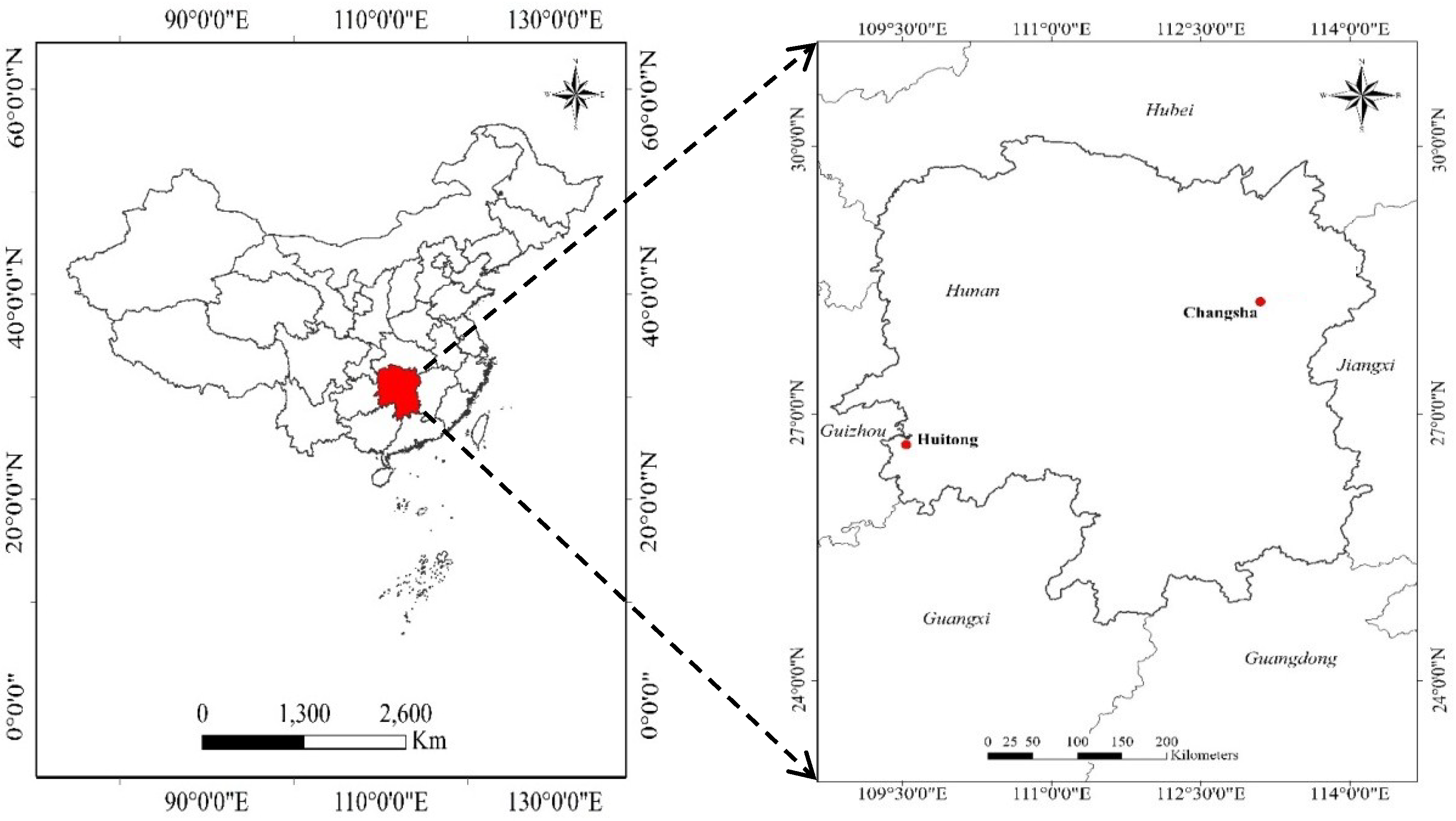
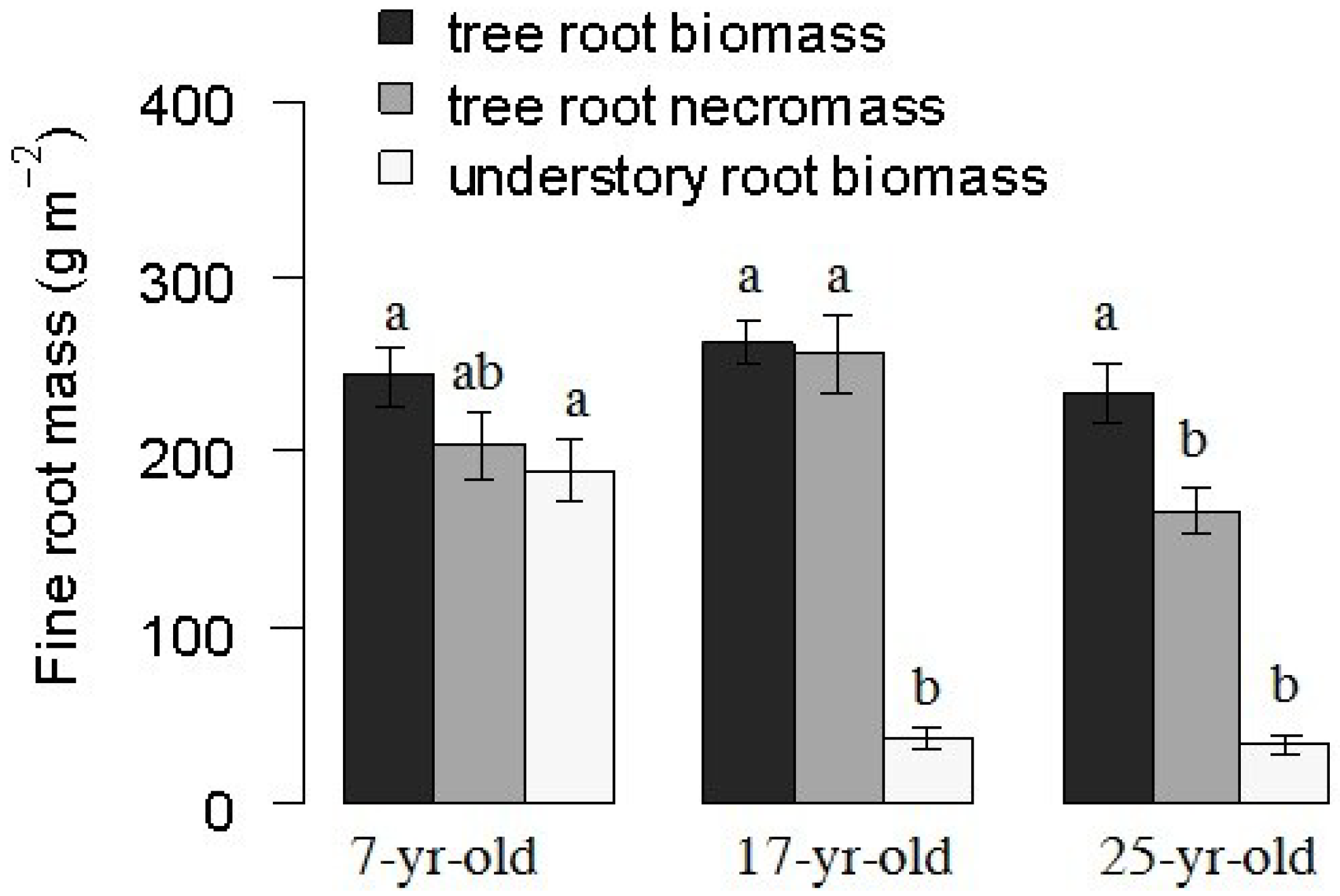
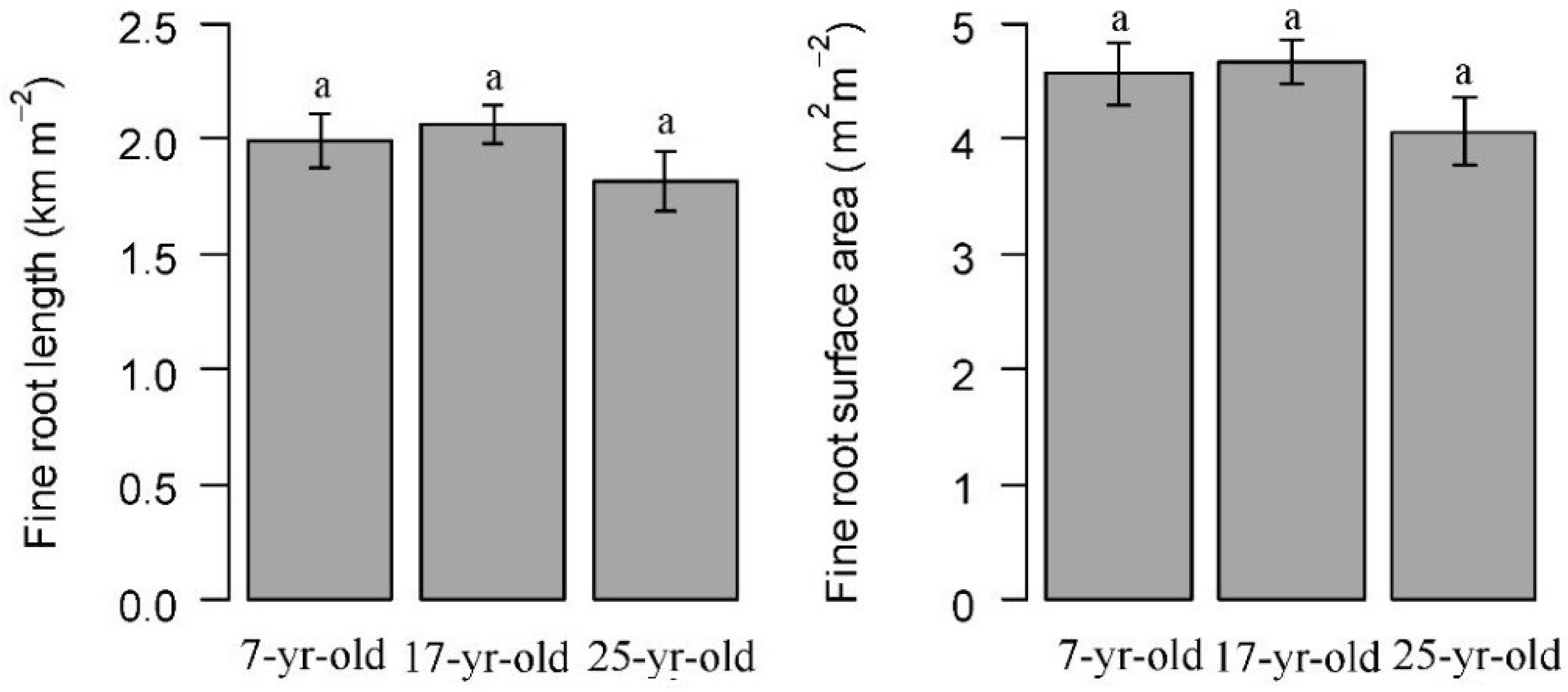
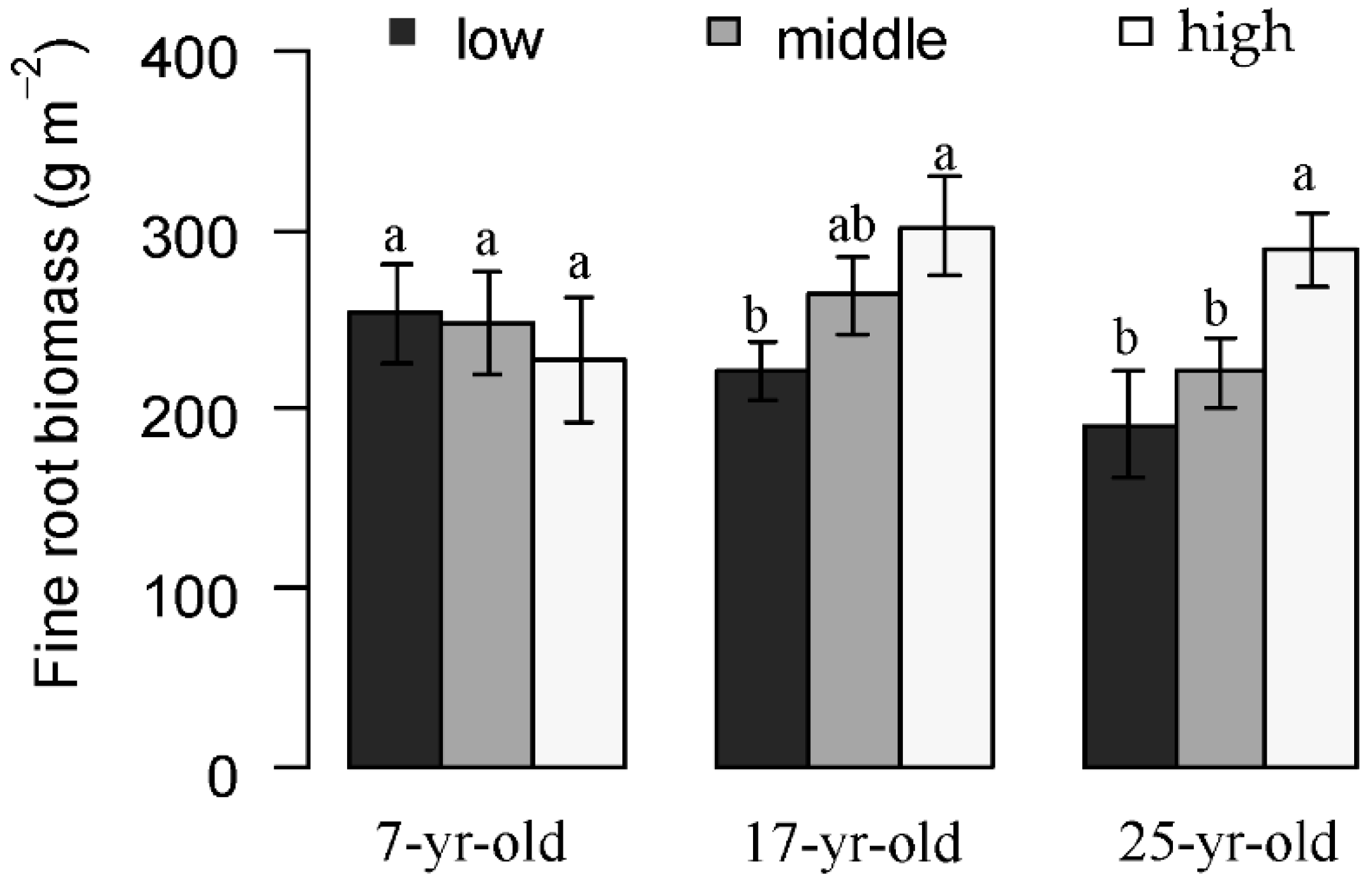
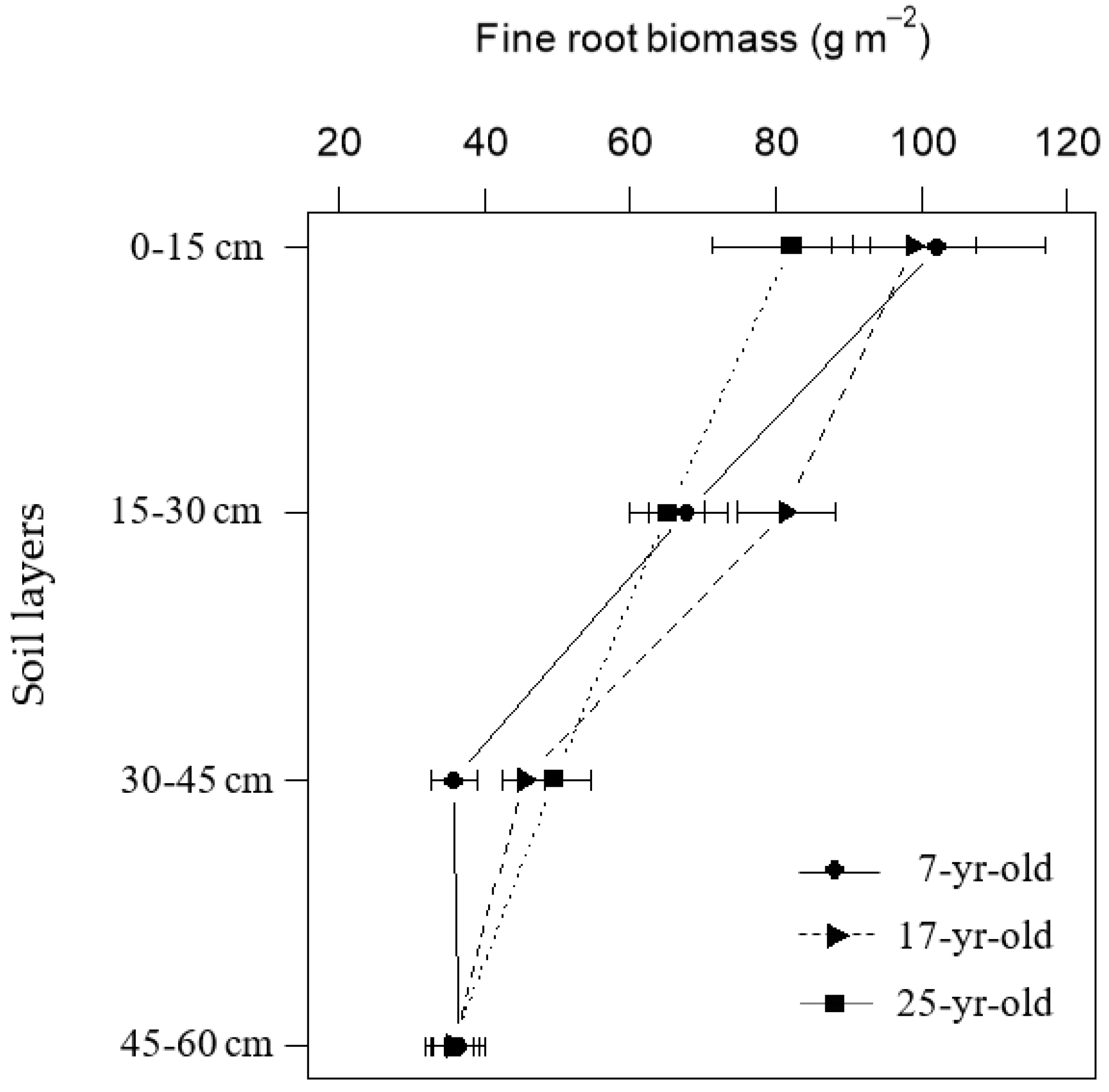
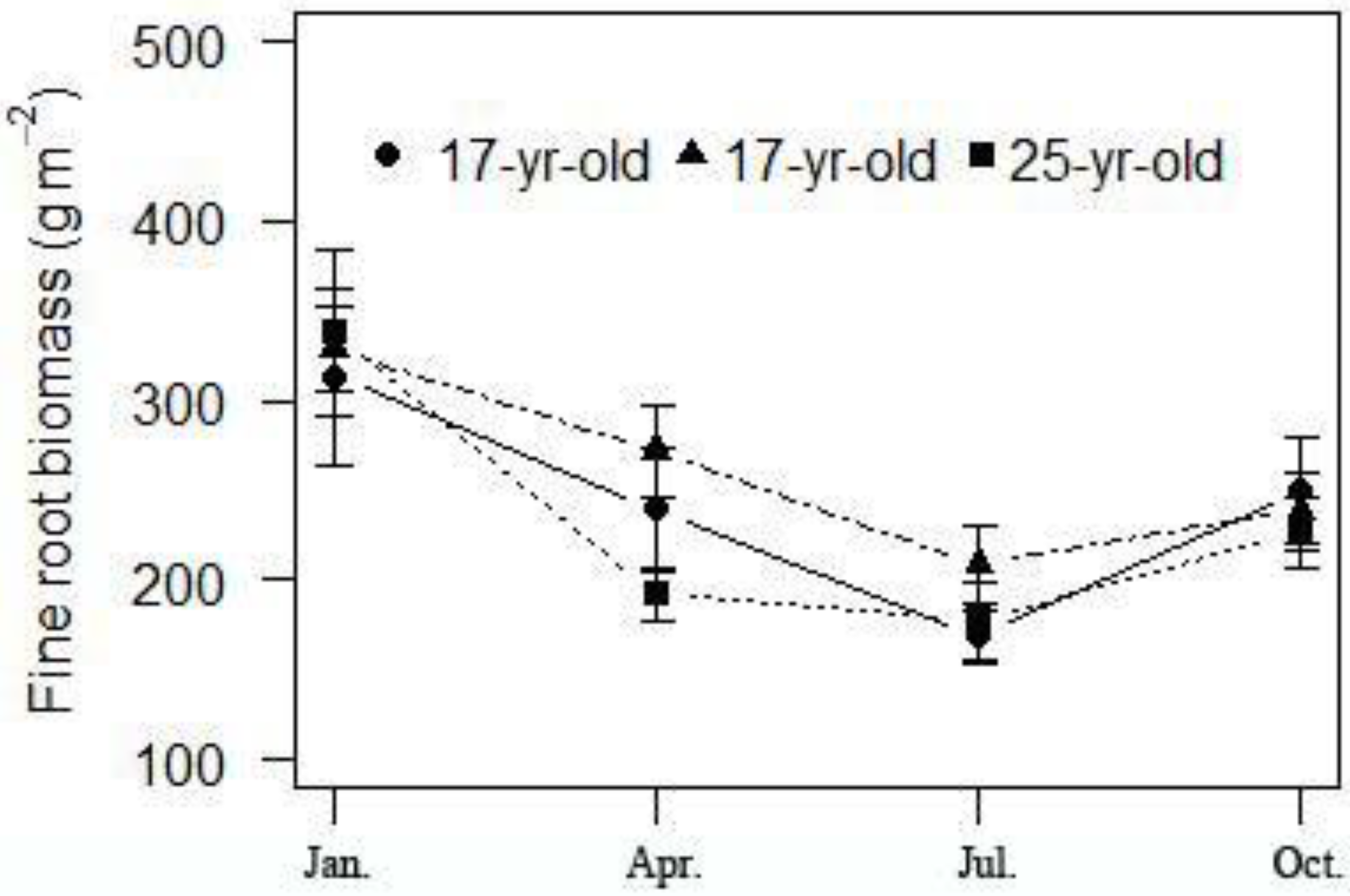
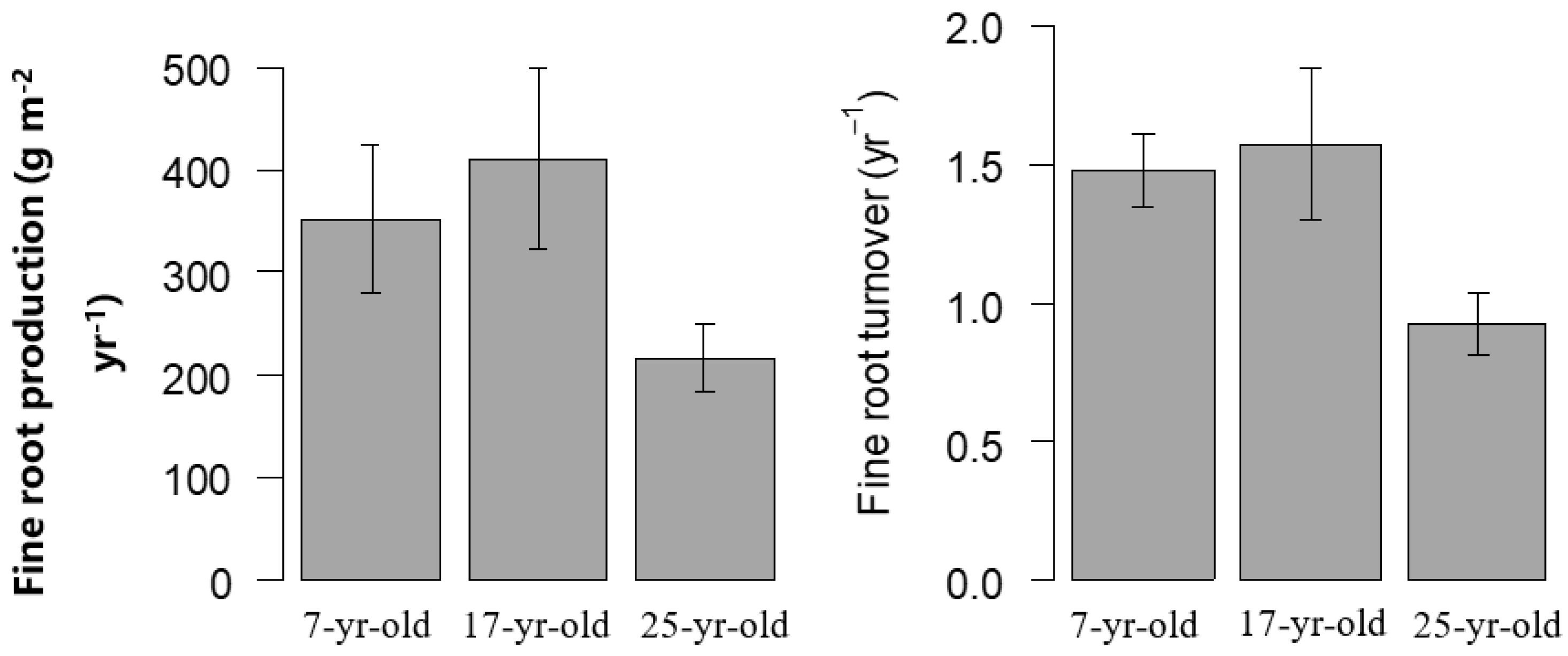
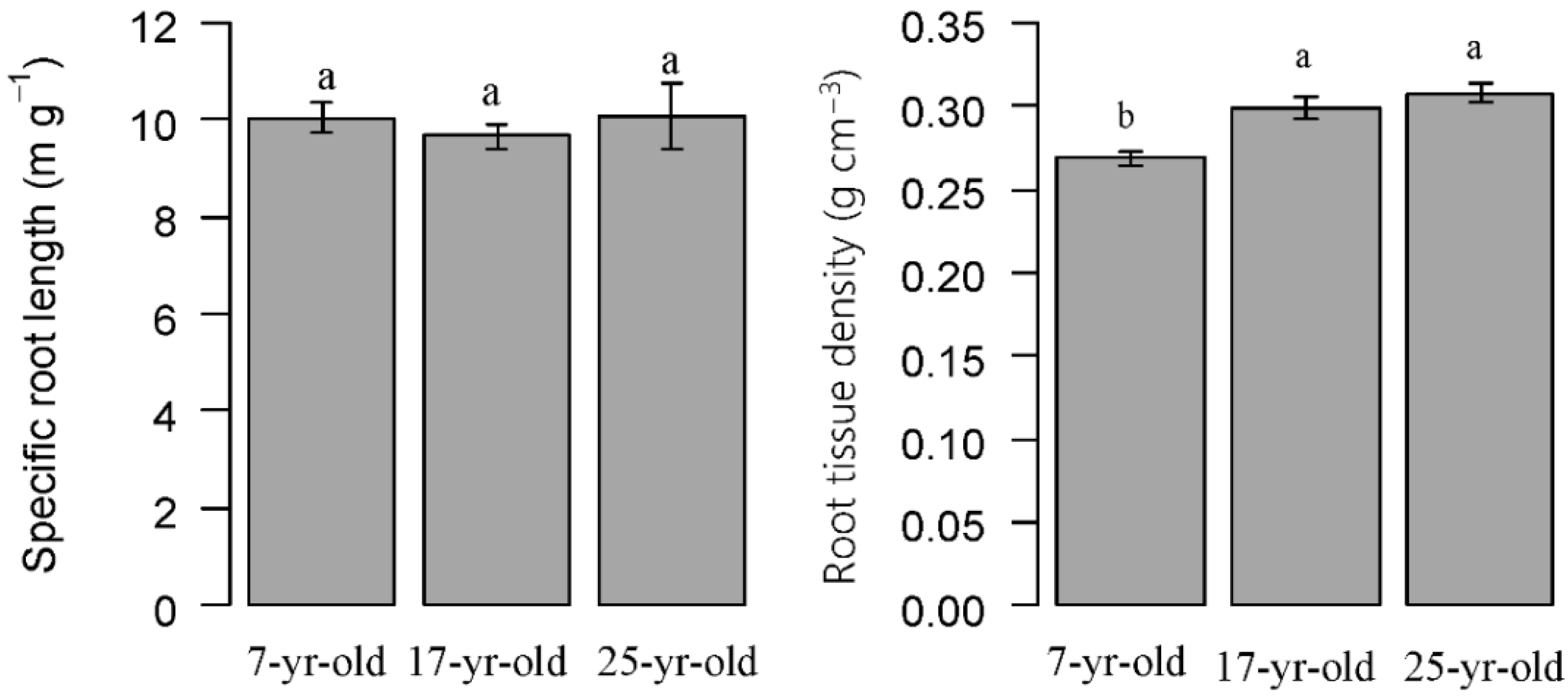
| Stand Age | Average Diameter at Breast Height (cm) | Average Tree Height (m) | Canopy Density | Stand Density (Stem·ha) | Slope (°) | Aspect |
|---|---|---|---|---|---|---|
| 7 | 6.7 | 5.6 | 0.7 | 2440 | 28 | north |
| 17 | 13.8 | 14.2 | 1.0 | 1825 | 25 | northeast |
| 25 | 17.1 | 16 | 0.9 | 1917 | 27 | northeast |
| Fixed Effects | df | SS | F | P |
|---|---|---|---|---|
| Fine root biomass (g m−2) | ||||
| Age | 2, 51 | 0.10 | 5.86 | 0.0030 |
| Depth | 3, 765 | 1.51 | 58.91 | <0.0001 |
| Season | 3, 765 | 0.40 | 15.70 | <0.0001 |
| Age × Depth | 6, 765 | 0.05 | 0.95 | 0.4607 |
| Age × Season | 6, 765 | 0.05 | 0.94 | 0.4688 |
| Depth × Season | 9, 765 | 0.11 | 1.47 | 0.1551 |
| Age × depth × season | 18, 765 | 0.10 | 0.67 | 0.8400 |
| Fine root necromass (g m−2) | ||||
| Age | 2, 51 | 0.64 | 11.50 | <0.0001 |
| Depth | 3, 765 | 1.48 | 17.88 | <0.0001 |
| Season | 3, 765 | 5.77 | 69.54 | <0.0001 |
| Age × Depth | 6, 765 | 0.03 | 0.17 | 0.9852 |
| Age × Season | 6, 765 | 0.76 | 4.55 | 0.0002 |
| Depth × Season | 9, 765 | 0.20 | 0.81 | 0.6063 |
| Age × depth × season | 18, 765 | 0.62 | 1.24 | 0.2214 |
| Understory root biomass (g m−2) | ||||
| Age | 2, 51 | 35.28 | 273.46 | <0.0001 |
| Depth | 3, 765 | 10.29 | 53.19 | <0.0001 |
| Season | 3, 765 | 1.21 | 6.26 | 0.0003 |
| Age × Depth | 6, 765 | 2.29 | 5.91 | <0.0001 |
| Age × Season | 6, 765 | 0.71 | 1.85 | 0.0873 |
| Depth × Season | 9, 765 | 0.52 | 0.90 | 0.5264 |
| Age × depth × season | 18, 765 | 0.62 | 0.53 | 0.9445 |
| Fine root length (km m−2) | ||||
| Age | 2, 51 | 0.73 | 7.93 | 0.0004 |
| Depth | 3, 765 | 8.03 | 58.53 | <0.0001 |
| Season | 3, 765 | 1.40 | 10.23 | <0.0001 |
| Age × Depth | 6, 765 | 0.36 | 1.31 | 0.2519 |
| Age × Season | 6, 765 | 0.49 | 1.79 | 0.0991 |
| Depth × Season | 9, 765 | 0.80 | 1.94 | 0.0430 |
| Age × depth × season | 18, 765 | 0.47 | 0.58 | 0.9175 |
| Fine root surface area (m2 m−2) | ||||
| Age | 2, 51 | 0.44 | 7.59 | 0.0005 |
| Depth | 3, 765 | 5.11 | 58.32 | <0.0001 |
| Season | 3, 765 | 1.15 | 13.07 | <0.0001 |
| Age × Depth | 6, 765 | 0.16 | 0.88 | 0.5058 |
| Age × Season | 6, 765 | 0.28 | 1.62 | 0.1388 |
| Depth × Season | 9, 765 | 0.47 | 1.77 | 0.0705 |
| Age × depth × season | 18, 765 | 0.35 | 0.67 | 0.8388 |
| Specific root length (m g−1) | ||||
| Age | 2, 51 | 0.03 | 1.42 | 0.2428 |
| Depth | 3, 765 | 0.18 | 5.98 | 0.0005 |
| Season | 3, 765 | 0.20 | 6.51 | 0.0002 |
| Age × Depth | 6, 765 | 0.14 | 2.26 | 0.0361 |
| Age × Season | 6, 765 | 0.08 | 1.32 | 0.2455 |
| Depth × Season | 9, 765 | 0.14 | 1.51 | 0.1402 |
| Age × depth × season | 18, 765 | 0.19 | 1.03 | 0.4246 |
| Root density (g cm−3) | ||||
| Age | 2, 51 | 0.04 | 13.23 | <0.0001 |
| Depth | 3, 765 | 0.05 | 12.59 | <0.0001 |
| Season | 3, 765 | 0.02 | 5.92 | 0.0005 |
| Age × Depth | 6, 765 | 0.01 | 0.83 | 0.5447 |
| Age × Season | 6, 765 | 0.00 | 0.45 | 0.8467 |
| Depth × Season | 9, 765 | 0.01 | 0.62 | 0.7825 |
| Age × depth × season | 18, 765 | 0.02 | 0.99 | 0.4729 |
© 2018 by the authors. Licensee MDPI, Basel, Switzerland. This article is an open access article distributed under the terms and conditions of the Creative Commons Attribution (CC BY) license (http://creativecommons.org/licenses/by/4.0/).
Share and Cite
Pei, Y.; Lei, P.; Xiang, W.; Ouyang, S.; Xu, Y. Effect of Stand Age on Fine Root Biomass, Production and Morphology in Chinese Fir Plantations in Subtropical China. Sustainability 2018, 10, 2280. https://doi.org/10.3390/su10072280
Pei Y, Lei P, Xiang W, Ouyang S, Xu Y. Effect of Stand Age on Fine Root Biomass, Production and Morphology in Chinese Fir Plantations in Subtropical China. Sustainability. 2018; 10(7):2280. https://doi.org/10.3390/su10072280
Chicago/Turabian StylePei, Yameng, Pifeng Lei, Wenhua Xiang, Shuai Ouyang, and Yiye Xu. 2018. "Effect of Stand Age on Fine Root Biomass, Production and Morphology in Chinese Fir Plantations in Subtropical China" Sustainability 10, no. 7: 2280. https://doi.org/10.3390/su10072280
APA StylePei, Y., Lei, P., Xiang, W., Ouyang, S., & Xu, Y. (2018). Effect of Stand Age on Fine Root Biomass, Production and Morphology in Chinese Fir Plantations in Subtropical China. Sustainability, 10(7), 2280. https://doi.org/10.3390/su10072280





